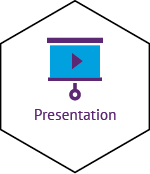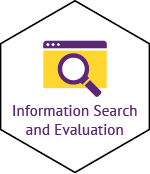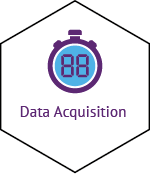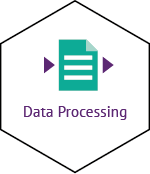Documentation

The competence area Documentation (DOC) comprises the individual ability to use digital tools for the systematic filing and permanent storage of data and information in order to use them professionally. This also includes taking, editing, and integrating photos, images, and videos, combining, and saving different media, structuring and archiving information, and displaying processes and contexts.
(Becker et al., 2020, p 23)
| Teaching (TPACK) |
Methods, Digitality (TPK) |
Content-specific context (TCK) |
Special tools (TK) |
|
|---|---|---|---|---|
| Name |
DOC.T.N1 Name digital techniques for documentation/ versioning or data archiving/ back-up creation for specific teaching-learning situations, e.g., experimentation, results of literature search. |
DOC.M.N1 Name methodological aspects that may be relevant when using digital documentation in the classroom, e.g.,
|
DOC.C.N1 Name options for professional digital documentation/ versioning and data archiving (e.g., gene databases, spectral databases, data sheets) while taking citation rules into account.
DOC.C.N2 Name methods of digital data documentation in research scenarios (e.g., image documentation: gel documentation, voxel files from MRI scans). |
DOC.S.N1 Name technical approaches, such as:
|
| Describe (including necessary procedures) |
DOC.T.D1 Describe didactically justified procedures for the appropriate use of digital techniques for documentation/versioning or data archiving/back-up creation in specific teaching/learning situations. | DOC.M.D1 Describe methodological advantages and disadvantages as well as limitations of specific digital technology in relation to teaching-learning situations. | DOC.C.D1 Describe options for proper digital documentation/versioning and data archiving (e.g., gene databases, spectral databases, data sheets), taking into account citation rules. |
DOC.S.D1 With regard to existing functions, technical framework conditions, technical requirements, technical advantages and disadvantages (e.g. automated back-ups), the possibilities to describe technical approaches to documentation listed under DOC.S.N1 shall be described.
DOC.S.D2 Describe the need to perform back-ups as part of digital data management and the procedure for performing a back-up, including restoring (recovering) the data. |
| Use/Apply (practical and functional realisation) |
DOC.T.A1 Planning and implementation of complete teaching scenarios with professional application of digital techniques for documentation/versioning or data archiving/back-up creation, taking into account suitable organizational and social forms. | DOC.S.A1 Subject-independent integration of the following principles into one’s own (also everyday) work:
|
Presentation

The competence area Presentation (PRE) describes the individual ability to use digital media in a targeted and addressee-oriented manner for the knowledge acquisition and communication process as well as the knowledge of the limits and potentials of different digital presentation media.
(Becker et al., 2020, p 23)
| Teaching (TPACK) |
Methods, Digitality (TPK) |
Content-specific context (TCK) |
Special tools (TK) |
|
|---|---|---|---|---|
| Name |
PRE.T.N1 Name suitable alternatives to (scientific) presentation media for school use (e.g., instead of an integrated microscope camera, a digital handheld microscope, mobile devices as a high-speed camera). PRE.T.N2 Name different scenarios for the appropriate use of digital presentation media in specific teaching/learning settings/contexts, (appropriate to the addressee, subject and target). |
PRE.M.N1 Name principles/criteria for designing digital presentation media appropriate for the target audience (e.g. CTML according to Richard E. Mayer, design psychology according to Wertheimer and Palmer). PRE.M.N2 Name possible aspects that can be affected by the use of digital presentation media in learning and teaching, e.g., with regard to:
|
PRE.C.N1 Name several subject-specific/specialist scenarios and, where appropriate, contexts for:
|
PRE.S.N1 Name several technical possibilities for presentation
|
| Describe (including necessary procedures) |
PRE.T.D1 Describe the didactic requirements for the use of digital presentation media in the classroom, the effects of these on the respective teaching methods, as well as the access to basic competencies (especially the competency area of communication) made possible by digital systems, especially in inclusive teaching and learning. |
PRE.M.D1 Describe principles/criteria for designing digital presentation media appropriate for the target audience (e.g., CTML according to Richard E. Mayer, design psychology according to Wertheimer and Palmer). PRE.M.D2 Describe the pedagogical requirements as well as the advantages and disadvantages that methodically emerge when using digital presentation media, e.g., with regard to:
|
PRE.C.D1 Describe selected scientific presentation forms and media by example, e.g.:
|
PRE.S.D1 For each type of presentation, describe at least one way of technical implementation including the necessary procedure with reference to current hardware and software and related technical standards. PRE.S.D2 Describe the features/functionality, technical requirements, and any limitations of each system |
| Use/Apply (practical and functional realization) |
PRE.T.A1 Planning and implementation of complete teaching scenarios with the integration of digital presentation media and forms and the consideration of suitable social and organizational forms. PRE.T.A2 Elementarize scientific representations with digital media for the school context. |
PRE.M.A1 Selection and/or adaptation of existing and own created presentation media, taking into account technical possibilities and limitations as well as principles/criteria for addressee-appropriate design. | PRE.C.A1 Creation and demonstration of presentations in a subject-specific context using digital presentation media, e.g.,
|
PRE.S.A1 Perform commissioning, calibration and usage for at least one example of each type of digital presentation capability listed above. |
Communication/Collaboration

The competence area Communication/Collaboration (COM) comprises the individual ability to plan synchronous or asynchronous work of individuals or groups with digital tools towards a common goal and to carry it out with learners. For this purpose, shared files or products are created and processed, common data pools are created and processed, and systems for assigning rights are planned and implemented.
(Becker et al., 2020, p 23)
| Teaching (TPACK) |
Methods, Digitality (TPK) |
Content-specific context (TCK) |
Special tools (TK) |
|
|---|---|---|---|---|
| Name |
COM.T.N1 Name hardware and/or software that is appropriate (appropriate to the addressee, subject, and target) for a specific teaching-learning situation. COM.T.N2 Name collaboration scenarios for entry, elaboration, and backup. COM.T.N3 Name the systems as an access or reinforcement for the communication competency area. |
COM.M.N1 List possible limitations and effects/aspects of the respective hardware or software use in the classroom with regard to:
|
COM.C.N1 Name collaborative projects in the subject sciences (e.g., Seti@Home, Stallcatchers). COM.C.N2 Name collaborative lab books as a way of collaborative working. COM.C.N3 Name collaborative document editing for publications and proposal submissions (e.g., via Google Docs or Microsoft 365). COM.C.N4 Mention communication with international colleagues using appropriate systems (e.g., via Skype or Adobe Connect). COM.C.N3 Name knowledge organization and structuring via appropriate content systems (e.g., CMS and wikis). |
COM.S.N1 Name software for collaborative text and data processing, (e.g., Microsoft 365, Google Docs, Etherpad). COM.S.N2 Name shareable cloud storage programs (e.g., state cloud, school cloud, Dropbox, OneDrive, Nextcloud/ownCloud, Sync’n’Share). COM.S.N3 Name systems for shareable network storage (e.g., WLAN storage, NAS). COM.S.N4 Name systems for data management. COM.S.N5 List options for version management. (e.g., file naming with sequential numbering, date-based file names, Subversion, Git). COM.S.N6 List collaborative systems and strategies for data and file management. |
| Describe (including necessary procedures) |
COM.T.D1 Describe deployment scenarios of an appropriate opportunity/strategy. COM.T.D2 Describe collaboration scenarios for entry, elaboration and backup (generic lesson planning). COM.T.D3 Describe didactic requirements for use in the classroom, effects of these on the respective teaching methods as well as access to basic competencies (especially the competence area communication) enabled by digital systems, also in inclusive learning and teaching. |
COM.M.D1 Describe advantages in teaching with regard to the aspects mentioned. COM.M.D2 Describe measures to counter possible negative effects e.g.:
|
COM.C.D1 Describe advantages of the above systems for research and individual projects. | COM.S.D1 Describe hardware/software combinations listed under COM.S.N1-6 in terms of their application. |
| Use/Apply (practical and functional realisation) |
COM.T.A1 Plan and implement complete instructional scenarios with appropriate use of each technique, considering appropriate organizational and social forms. COM.T.A2 Instructing learners in the techniques. |
COM.S.A1 Use collaborative software for text and data processing. COM.S.A2 Use storage systems, e.g., state cloud, school cloud. COM.S.A3 Use shared storage systems, e.g., WLAN storage, NAS. COM.S.A4 Use systems for data management. COM.S.A5 Create and revise (synchronously and asynchronously) collaborative text and data files. |
Information Search and Evaluation

The competence area Information Search and Evaluation (ISE) includes the individual ability to use digital tools to obtain information on given subject areas or to solve problems, and to structure and evaluate them. For this purpose, search targets are defined, various information sources are integrated and evaluated.
(Becker et al., 2020, p 23)
| Teaching (TPACK) |
Methods, Digitality (TPK) |
Content-specific context (TCK) |
Special tools (TK) |
|
|---|---|---|---|---|
| Name |
ISE.T.N1 Name conditions and scenarios for the appropriate use of databases or literature databases in teaching-learning scenarios. ISE.T.N2 List criteria for evaluating the results of a search. ISE.T.N3 Name the steps of a successful Internet-based information search or problem solving (e.g. according to the IPS-I model of Brand-Gruwel, Wopereis, and Walraven):
|
ISE.M.N1 List advantages, disadvantages, and limitations of digital databases and search engines for use in teaching-learning scenarios. ISE.M.N2 List advantages, disadvantages, and limitations for using digital sources in teaching-learning scenarios. |
ISE.C.N1 Name several science-specific databases/data archives (e.g., gene databases, spectral databases, collection inventory databases). ISE.C.N2 Name several literature databases or search engines (e.g., OPAC, google scholar, web of science, scopus). ISE.C.N3 Name at least two quality criteria for evaluating digital sources from a discipline perspective e.g.:
|
ISE.S.N1 Name search options for digital research e.g.:
ISE.S.N3 List aspects of building and using/creating databases, e.g.:
|
| Describe (including necessary procedures) |
ISE.T.D1 Describe appropriate use scenarios of digital searches, e.g., in (subject-specific) databases or literature databases, and how to conduct an evaluation of the results based on the quality criteria. ISE.T.D2 Describe the steps of a successful Internet-based information search or problem solving based on a science teaching example in the steps listed under ISE.T.N3. |
ISE.M.D1 Describe advantages, disadvantages, and limitations of digital databases and search engines for use in teaching-learning scenarios. ISE.M.D2 Describe advantages, disadvantages, and limitations for using digital sources in teaching-learning scenarios. |
ISE.C.D1 Describe subject-specific options for digital research, e.g., OPAC, subject databases, and electronic full texts. ISE.C.D2 Describe strategies for extracting information from digital sources. ISE.C.D3 Describe features of two science-specific databases. ISE.C.D4 Describe characteristics of two literature databases or search engines. ISE.C.D5 Describe at least two of the quality criteria listed in ISE.C.N3, e.g., scope, data volume/resolution, professionalism/scientificity, validity, reliability, and review procedures. |
ISE.S.D1 Describe a research strategy (problem analysis, keywords, synonyms, and search services). ISE.S.D2 Describe quality criteria for evaluating the validity of digital sources, e.g.:
|
| Use/Apply (practical and functional realisation) |
ISE.T.A1 Planning and implementation of complete teaching scenarios including research e.g. in (subject-specific) databases or literature databases as well as the evaluation of the results based on the quality criteria and the consideration of appropriate social and organizational forms. ISE.T.A2 Planning and implementation of science teaching scenarios integrating the steps of a successful internet-based information search or problem solving in the steps listed under ISE.T.N3. |
ISE.M.A1 Planning and implementation of teaching scenarios in which the (subject-independent) advantages and disadvantages as well as limitations of digital databases and search engines are addressed. | ISE.C.A1 Conduct a subject-specific search according to the quality criteria and evaluate the results found. |
Data Acquisition

The competence area Data Acquisition (DAQ) describes the individual ability to collect data directly or indirectly with digital tools by entering data, digitising analogue data, taking images, and making films, using probes, sensors, and programs (or apps), and obtaining data from documentation media such as images or videos.
(Becker et al., 2020, p 23)
| Teaching (TPACK) |
Methods, Digitality (TPK) |
Content-specific context (TCK) |
Special tools (TK) |
|
|---|---|---|---|---|
| Name |
DAQ.T.N1 Name suitable alternatives to scientific digital data acquisition for school use. DAQ.T.N2 Name specific scenarios for an appropriate use (pupil-, subject- and target-oriented) of digital data acquisition and associated measurement strategies in various teaching-learning settings, e.g.,
|
DAQ.M.N1 Name further aspects on which the use of digital data acquisition in learning and teaching may have an impact, e.g.,
|
DAQ.C.N1 Name scientific scenarios and contexts of digital data acquisition (e.g., video analysis, ECG recording, determination of pH values).
DAQ.C.N2 Name measuring equipment with digital data acquisition (e.g., thermal imaging cameras, mobile devices with cameras, integrated and external sensors) meeting the current requirements of scientific research. DAQ.C.N3Name corresponding measurement systems and relevant safety standards DAQ.C.N4Name remote-controlled laboratories (for example, telescopes) for experiments that cannot be performed on site. |
DAQ.S.N1 Name several fields of application for digital data acquisition, e.g.,
|
| Describe (including necessary procedures) |
DAQ.T.D1 Describe didactic requirements for the use of digital data acquisition systems in teaching (e.g., individually adapted user instructions), effects of daq on the respective teaching methods (e.g., enabling research-based exploratory learning by mobile devices), access to basic competences, knowledge acquisition and NOS concepts enabled by digital systems. | DAQ.M.D1 Describe pedagogical requirements as well as advantages and disadvantages arising methodically from the use of digital data acquisition, for example, with regard to the aspects as listed under DAQ.M.N1. | DAQ.C.D1 Describe selected scientific scenarios of digital data acquisition as examples. |
DAQ.S.D1 Describe at least one possibility of technical implementation for each type of digital data acquisition including necessary procedures in terms of current hard- and software and associated standards.
DAQ.S.D2 Describe the measuring characteristics (e.g., measuring range, measuring accuracy, resolution, sampling rate, fields of application, limitations) of the systems. |
| Use/Apply (practical and functional realisation) |
DAQ.T.A1 Planning and realization of complete teaching scenarios using digital data acquisition in consideration of appropriate social and organisational structures. |
DAQ.C.A1Acquisition of measured values in a subject-specific context using digital data acquisition, e.g.,
|
DAQ.S.A1 Perform setup, calibration, and data acquisition for at least one example each of the above-mentioned range of application for digital data acquisition. |
Data Processing

The competence area Data Processing (DAP) describes the individual ability to process data with digital tools. This includes filtering, calculating new quantities, processing, statistical analysis and merging of data sets.
(Becker et al., 2020, p 23)
| Teaching (TPACK) |
Methods, Digitality (TPK) |
Content-specific context (TCK) |
Special tools (TK) |
|
|---|---|---|---|---|
| Name |
DAP.T.N1 Name tools for the appropriate use (appropriate to the addressee, subject and target) of data processing. DAP.T.N2 Name scenarios for the use of the mentioned possibilities of data processing in specific teaching-learning situations with fit to a context that is relevant to the subject. |
DAP.M.N1 Name prior knowledge and competences of the learners necessary for a teaching-learning situation in order to use the techniques. DAP.M.N2 Name methodological aspects of learning and teaching about digital data processing, e.g. regarding:
|
DAP.C.N1 Name quasi-established procedures of digital data processing in the subject area. DAP.C.N2 Name subject-specific scientific scenarios with associated methods of subject-specific data processing, e.g.:
|
DAP.S.N1 Name different data types and encodings and associated data or file formats (and operations allowed with them), e.g. for:
DAP.S.N4 Name ways to export and import digital data of the named data types and encodings. DAP.S.N3 Name ways of converting data and data formats. |
| Describe (including necessary procedures) |
DAP.T.D1 Describe didactic prerequisites of digital data processing for use in and effects on the respective teaching methods. DAP.T.D2 Describe access to basic competencies (especially to the competency area of knowledge acquisition) made possible by digital data processing. |
DAP.M.D1 Describe ways to protect and anonymize personal data. DAP.M.D2 Describe advantages and disadvantages of methodical aspects of digital data processing in learning and teaching. Describe aspects of digital data processing in learning and teaching, e.g. with regard to:
|
DAP.C.D1 Describe subject-specific scenarios with associated methods in which subject-specific data processing occurs. |
DAP.S.D1 Describe properties of data types and formats and changes associated with conversion. DAP.S.D2 Describe procedures (e.g., statistical programs, spreadsheets, databases) for
DAP.S.D4 Describe possibilities of converting data and data formats. DAP.S.D5 Describe data structure of xml, csv files (also with semicolon separation). |
| Use/Apply (practical and functional realisation) |
DAP.T.A1 Planning and implementation of full teaching scenarios with the integration of digital data processing and the consideration of suitable social and organizational forms. |
DAP.S.A1Apply methods (e.g., statistical programs, spreadsheets, databases) for the
DAP.S.A3 Convert data and data formats with selected software. |
Simulation and Modelling

The competence area Simulation and Modelling (SIM) describes the individual skills to perform computer-aided modelling and to use existing digital simulations in a targeted and addressee-oriented manner for the knowledge acquisition and communication process as well as the knowledge of limits and potentials of models and simulations in the process of knowledge acquisition.
(Becker et al., 2020, p 23)
| Teaching (TPACK) |
Methods, Digitality (TPK) |
Content-specific context (TCK) |
Special tools (TK) |
|
|---|---|---|---|---|
| Name |
SIM.T.N1 Name scenarios for appropriate use of digital simulations and modeling (e.g., spreadsheet, Geogebra for use in teaching) as well as software and strategies for use in a specific teaching-learning scenario, e.g.,
|
SIM.M.N1 Name advantages, disadvantages, typical features and limitations in teaching-learning scenarios considering, e.g.,
|
SIM.C.N1 Name several science scenarios in which simulation or modeling is used to gain knowledge (e.g., temperature fields, magnetic fields, climate models). SIM.C.N2 Name at least two methods of digital simulation or modeling in research scenarios (e.g., Lotka-Volterra population dynamics). SIM.C.N3 Name several data sources from which data applicable to modeling can be drawn/referenced (e.g., weather data, populations, measurements from professional sciences). SIM.C.N4 Name insights gained from simulations (e.g., material stress, crash testing, weather forecasting, global warming). SIM.C.N5 Name different target categories of the use of simulations:
|
SIM.S.N1 Name several programs or web packages that can be used to perform simulations and modeling (away from a spreadsheet such as Excel). SIM.S.N2 Name data fundamentals, skills, and necessary prior knowledge of the operator/user required for digital modeling, such as:
|
| Describe (including necessary procedures) |
SIM.T.D1 Describe didactic prerequisites for the use of simulations and modeling in the classroom and their effects on the respective teaching methods as well as access to basic competencies made possible by digital systems (especially in the competency area of knowledge acquisition and, if applicable, communication). |
SIM.M.D1 Describe and evaluate simulations and modeling software in terms of motivation (usability, attractiveness, clarity of description and objectives), content (relevance, scope, correctness) and methodology (flexibility, matching to target group, realization, documentation). SIM.M.D2 Describe advantages and disadvantages compared to analog simulations (business games). |
SIM.C.D1 Describe the gain of knowledge with simulations and their advantages/disadvantages as well as their epistemological limitations in different concrete research scenarios. |
SIM.S.D1 Edit the functional scope of the named packages or programs with regard to:
|
| Use/Apply (practical and functional realisation) |
SIM.T.A1 Planning and implementation of complete teaching scenarios with the integration of simulations or modeling and the consideration of appropriate social and organizational forms. | SIM.S.A1 Perform at least one modeling exercise including simulation and results validation. |
Technical Core Competencies
The competence area Technical Core Competencies (TCC) describes the basic individual skills and abilities to name, describe and use common connection systems and interfaces (e.g., HDMI, USB, and their connector formats). Furthermore, wireless connection standards should be named and their range as well as connection processes should be described. The aim is to be able to set up and use functional working environments independently, and to solve arising technical problems.
(Becker et al., 2020, p 23)
Legal Framework
The competence area Legal Framework (LEG) describes the individual ability to identify legal issues when using digital media and platforms in schools, such as data protection regulations for the processing and storage of personal data, licensing regulations, age and content restrictions, and copyright. This also includes basic knowledge needed for clarification in this regard before use.
(Becker et al., 2020, p 23)
